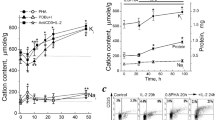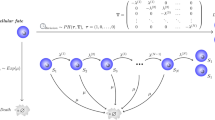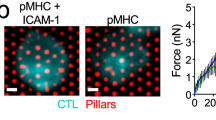Abstract
Concentrations of concanavalin A or the calcium ionophore A23187 that are optimal for the transformation of pig or mouse lymphocytes do not normally cause a measurable increase in calcium influx compared with unstimulated cells. If the cells are treated with the mitogens in conditions where a measurable increase in calcium influx occurs, no stimulation of the cells can occur while the flux is maintained. If any early influx of extracellular calcium is necessary for stimulation, then a much smaller increase in the total concentration of cellular calcium than reported previously is sufficient to allow the entry of lymphocytes into the cell cycle.
This is a preview of subscription content, access via your institution
Access options
Subscribe to this journal
Receive 51 print issues and online access
$199.00 per year
only $3.90 per issue
Buy this article
- Purchase on Springer Link
- Instant access to full article PDF
Prices may be subject to local taxes which are calculated during checkout
Similar content being viewed by others
References
Allwood, G., Asherson, G. L., Davey, M. J. & Goodford, P. J. Immunology 21, 509–516 (1971).
Whitney, R. B. & Sutherland, R. M. Cell Immunol. 5, 137–147 (1972).
Whitney, R. B. & Sutherland, R. M. J. Cell Physiol. 82, 9–20 (1973).
Parker, C. W. Biochem. biophys. Res. Commun. 61, 1180–1186 (1974).
Hovi, T., Allison, A. C. & Williams, S. C. Expl Cell Res. 97, 92–100 (1976).
Freedman, M. H., Raff, M. C. & Gomperts, B. Nature 255, 378–382 (1975).
Diamantstein, T. & Ulmer, A. Immunology 28, 121–125 (1975).
Greene, W. C., Parker, C. M. & Parker, C. W. Cell Immunol. 25, 27–89 (1976).
Raff, M. C., Freedman, M. H. & Gomperts, B. In Membrane Receptors of Lymphocytes (eds M. Seligmann, J.L. Preud'homme & F.M. Kourilsky) 393–398 (North-Holland, Amsterdam, 1975).
Freedman, M. H. & Gelfand, E. W. In Immunological Receptors (ed. B. Cinader) (in press).
Andreasen, P. A. et al. Analyt Biochem. 59, 610–616 (1974).
Maino, V. C., Green, N. M. & Crumpton, M. J. Nature 251, 324–327 (1974).
Roos, D. & Loos, J. A. Expl Cell Res. 77, 127–135 (1973).
Kay, J. E., Ahern, T. & Atkins, M. Biochim. biophys. Acta. 247, 322–334 (1971).
Habu, S. & Raff, M. C. Eur. J. Immunol. (in the press).
Schreiner, G. F. & Unanue, E. R. J. exp. Med. 143, 15–31 (1976).
Ling, N. R. & Kay, J. E. in Lymphocyte Stimulation 30, (North-Holland/American Elsevier, Amsterdam and New York, 1975).
Author information
Authors and Affiliations
Rights and permissions
About this article
Cite this article
Hesketh, T., Smith, G., Houslay, M. et al. Is an early calcium flux necessary to stimulate lymphocytes?. Nature 267, 490–494 (1977). https://doi.org/10.1038/267490a0
Received:
Accepted:
Issue Date:
DOI: https://doi.org/10.1038/267490a0
This article is cited by
-
Role of ion channels in lymphocytes
Journal of Clinical Immunology (1991)
-
Calcium uptake and efflux during the yeast to mycelium transition inSporothrix schenckii
Mycopathologia (1990)
-
Early steps of lymphocyte activation bypassed by synergy between calcium ionophores and phorbol ester
Nature (1985)
-
Antigen-dependent increase in cytosolic free calcium in specific human T-lymphocyte clones
Nature (1985)
-
Ion channels in lymphocytes
Journal of Clinical Immunology (1985)
Comments
By submitting a comment you agree to abide by our Terms and Community Guidelines. If you find something abusive or that does not comply with our terms or guidelines please flag it as inappropriate.



